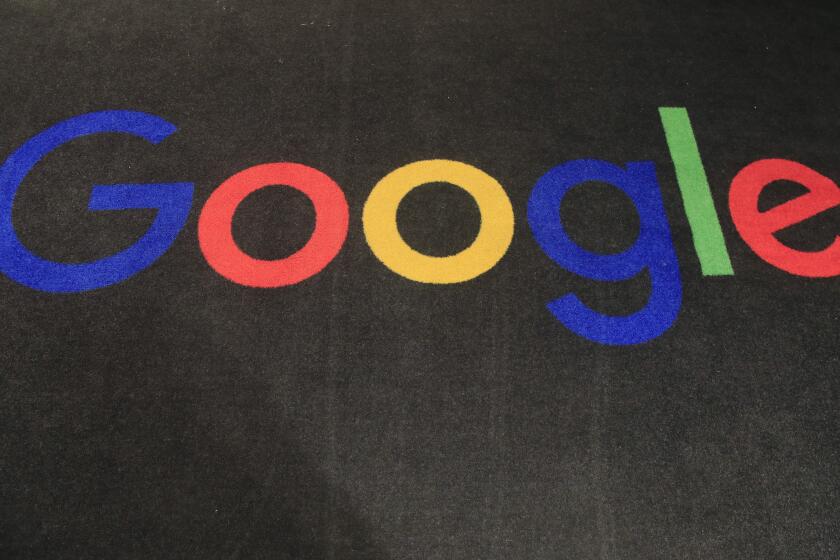Hundreds of Stores to Get Different Name -- Macy’s
- Share via
Goodbye, Robinsons-May.
The end officially comes this weekend for the storied Los Angeles chain as Federated Department Stores Inc. completes a massive make-over that will rebrand shopping nameplates across America.
Houston is losing Foley’s; Filene’s will no longer be a Boston institution; Chicago is saying farewell to Marshall Field’s; and Famous-Barr, based in St. Louis, is finished, along with seven former regional chains that also are becoming Macy’s on Saturday.
But the question in the malls this fall is whether shoppers are ready to say hello to Macy’s, the department store giant that doubles in size this weekend.
“I’m just kind of disappointed,” mused Phyllis Jacob, a 66-year-old legal secretary from West L.A. as she perused the changes at her old Westside Pavilion Robinsons-May. “Maybe it’s just something to get used to.”
With much fanfare, parades and advertising like crazy, Macy’s is throwing a nationwide party to officially unveil the renamed and revamped May Co. stores it bought a year ago for $11 billion.
Which stores benefit -- Macy’s or its competitors -- will be unclear until Christmas or later.
“Competition is ferocious, make no mistake,” said Kurt Barnard, president of Barnard’s Retail Consulting Group in New York. “First of all, there is Target, there is Kohl’s, J.C. Penney; there are so many others and they all have the opportunity to show their mettle.”
“They are going to try their level best to steal market share from Macy’s,” he added, “but Macy’s, in general, is well prepared.”
Nationwide, Federated will be converting about 400 former May Co. stores, which operated under 11 different names including Robinsons-May, to the Macy’s brand.
That will give the Cincinnati-based company, with more than $27 billion in annual sales, more than 800 stores in 45 states.
In California, of the 49 Robinsons-May stores Federated acquired, 26 were shuttered and 23 officially will be renamed Macy’s on Saturday. In all, Federated will have 71 Macy’s stores in Southern California for a total of 111 stores and 31,000 employees across the state. That’s in addition to its six Bloomingdale’s stores in California.
Federated is literally rolling out the red carpet as part of efforts to welcome customers into Macy’s stores. Employees will distribute gift cards, host celebrity appearances, offer craft projects for kids and hand out as many cupcakes, jelly beans and other goodies as they can foist on passersby.
And to get the word out, the company is launching its largest-ever advertising blitz, with newspaper, magazine and billboard advertisements.
Radio and television spots in English and Spanish will feature a reworked version of the Motown hit “Dancing in the Streets” -- calling out the names of cities getting new Macy’s stores.
“We look at this as a once-in-a-lifetime opportunity,” Federated Chairman Terry Lundgren told investors Wednesday at the Goldman Sachs Global Retailing Conference in New York. “We intend to bring affordable luxury and fashion to America with this launch.”
Now all he needs is to boost sales and profits, something that analysts say will be a daunting challenge.
“I think the perception is that Macy’s is a little higher fashion content and a little higher quality and a little higher price,” said Bob Buchanan, a financial analyst with A.G. Edwards in St. Louis. “That perception, which does involve a dollop of reality, will probably shift some moderate shoppers over toward Kohl’s and Mervyns and Penney’s.”
That’s where the real money is, Buchanan said, because fewer customers buy at the higher end. Federated’s challenge is to keep those moderate customers by keeping costs in line a tough battle when up against ultra-efficient players such as Kohl’s.
“As I look at the whole equation, the big winner over the next 12 to 18 months is going to be Kohl’s,” he said. “I think the big loser could be Federated, because up until now, they’ve been unable to gain much efficiencies as a result of the merger.”
Kohl’s Corp., J.C. Penney Co. and Target Corp., declined to comment. Nordstrom Inc. did not return calls.
Across the country, regional department store chains traditionally have endured by catering to local tastes and offering shoppers a bit of local tradition: Frango Mints and Christmas windows at Chicago’s beloved Marshall Field’s stores, the annual Christmas tree lighting at Filene’s in Boston and Macy’s Thanksgiving Day parade in New York City.
The store names evoked images of hometown 19th century dry-goods salesmen done good: Lyman S. Ayres in Indianapolis, George Draper Dayton in Minneapolis, Joseph Winchester Robinson in Los Angeles, David May in Leadville, Colo.
Robinson, the son of a Massachusetts merchant, opened the Boston Dry Goods store at Temple and Spring streets in Los Angeles in 1883. It grew into a tony retailer with a fancy Wilshire Boulevard address at its best-known store in Beverly Hills.
Robinson’s became a place that drew leading designers, top fashion models and European royalty to launch their collections. The store took on the May name a few years after merging with May Department Stores Co. in 1986.
But consolidation and years of battering by discounters dragged many of the department store chains into a cycle of flagging sales and dreary stores. Through mergers, or in ill-fated attempts to appeal to a wider array of shoppers, many of the once-proud chains slid into homogenous warehouses with racks of indistinguishable merchandise.
In a nod to tradition, Macy’s promised Chicago that it would keep their mints and told Boston that the tree lighting would go on. In Southern California, however, few shoppers gave the changeover a second thought.
“With fewer and fewer department stores, whether it has a May name or a Federated name or anything else probably doesn’t matter,” said Michael Niemira, chief economist for the International Council of Shopping Centers.
Karen and Brent Byrd of Rancho Park said that although they loved the old Robinson’s, the stores being changed over this weekend began to lose their luster back in 1993, when St. Louis-based May first added its name to the local signs.
“That was the death knell,” said Karen Byrd, 54, who runs a radiology network. “May was a step down.”
Taking in the new brighter, wider aisles at the Westside Pavilion store, with entryways already adorned by the bright red Macy’s logo, the couple said they had higher hopes for the new store.
“I’m not sure Robinsons-May ever established its own identity,” said Brent Byrd, a 50-year-old certified public accountant: “You didn’t know it for great service or great merchandise, it just sort of went along.”
Those who said they missed Robinsons-May mostly pointed to value.
“Me and my friends, we’re all missing it,” said Cristina Gregory, a 48-year-old jewelry designer from Santa Monica. “I hope they’ll have more quality items at more affordable prices than what Macy’s is known for.”
In Southern California, the acquisition of Federated left some malls with duplicate stores and others with an empty anchor spot to fill. Glendale Galleria, Northridge Fashion Center and Lakewood Center, which had hosted both Macy’s and Robinsons-May, will now just have a single Macy’s store.
South Coast Plaza in Costa Mesa will keep the three Macy’s stores it has had for the last few years: a Macy’s, a Macy’s Men’s Store, and a Macy’s Home Furniture store. The mall’s Robinsons-May store will become a Bloomingdale’s.
At the giant Del Amo Fashion Center in Torrance, Federated will operate a Macy’s home store and, for the ultimate in convenience, two full Macy’s stores in the spots that once held the two competitors.
“We’re not only a survivor but a thriver,” said Robert Mettler, chairman of Macy’s West. “And to be able to do things uniquely different for our marketplace is very exciting.”
Abigail.Goldman@latimes.com
*
(BEGIN TEXT OF INFOBOX)
Rechristened
Here are some of the department store chains that are becoming part of Macy’s.
Robinsons-May: Robinson’s founded in 1883 in Los Angeles and May in 1877 in Leadville, Colo.; the chains merged in 1993. Stores in California, Arizona and Nevada.
Foley’s: Founded in 1900 in Houston. Stores in Texas, Oklahoma, New Mexico, Colorado and Louisiana.
Filene’s: Founded in 1881 in Boston. Stores in Massachusetts, New York, Maine, New Hampshire, Connecticut, Rhode Island and Vermont.
Famous-Barr: Founded in 1911 in St. Louis. Stores in Missouri, Illinois, Indiana and Kentucky.
Marshall Field’s: Founded in 1881 in Chicago. Stores in Illinois, Michigan, Ohio, Indiana, Wisconsin, Minnesota, North Dakota and South Dakota.
Hecht’s: Founded in 1857 in Baltimore. Stores in Maryland, Virginia, the District of Columbia, Pennsylvania, North Carolina and Tennessee.
Kaufmann’s: Founded in 1871 in Pittsburgh. Pennsylvania, Ohio, New York and West Virginia.
Meier & Frank: Founded in 1857 in Portland, Ore. Stores in Oregon, Washington and Utah.
Source: Times research by Scott Wilson
Los Angeles Times
*
(BEGIN TEXT OF INFOBOX)
A retail history
* 1877: May Department Stores founder David May opens his first store, a mining supply shop in Leadville, Colo.
* 1883: Joseph Winchester Robinson opens the Boston Dry Goods store at Temple and Spring streets in Los Angeles.
* 1891: Robinson’s company is incorporated as J.W. Robinson.
* 1923: May Department Stores opens its first Los Angeles store.
* 1955: Associated Dry Goods buys J.W. Robinson.
* 1986: May Department Stores buys Associated Dry Goods; Robinson’s and May stores continue to operate separately.
* 1993: Robinson’s and May chains merge, forming the Robinsons-May store brand.
* 2005: Federated Department Stores buys May Department Stores.
* 2006: Robinsons-May stores are renamed Macy’s.
Source: Times research
More to Read
Inside the business of entertainment
The Wide Shot brings you news, analysis and insights on everything from streaming wars to production — and what it all means for the future.
You may occasionally receive promotional content from the Los Angeles Times.










